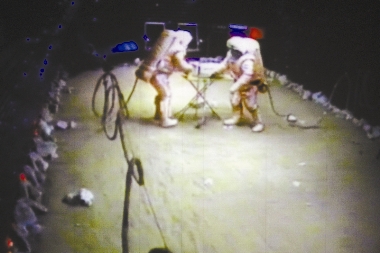 火星-500项目成功模拟着陆 After 257 days in a locked, windowless steel capsule, researchers on a mock trip to Mars ventured from their cramped quarters in heavy space suits Monday, trudging into a sand-covered room to plant flags on a simulated Red Planet. The all-male crew of three Russians, a Frenchman, an Italian-Colombian and a Chinese entered a network of modules at a Moscow space research center last June to imitate the 520-day flight and see how they cope with the constricted, isolating conditions of space travel — minus the weightlessness. Several participants donned 30-kilogram suits to perform Monday’s mock landing in an adjacent capsule. They planted the flags of Russia, China and the European Space Agency, took “samples” from the ground and conducted faux scientific experiments. “All systems have been working normally. The crew are feeling fine,” said Vitaly Davydov, deputy head of the Russian space agency. Psychologists said long confinement would put the team members under stress as they grow increasingly tired of each other’s company. Psychological conditions can even be more challenging on a mock mission than a real flight because the crew won’t experience any of the euphoria or dangers of actual space travel. Davydov described the experiment as an important part of preparation for a flight to Mars and predicted that the real mission could take place in about 20 years, but only with international cooperation. The facility in western Moscow includes living compartments the size of a bus connected with several other modules for experiments and exercise. The video footage of the landing was shown on a big screen at Russia’s Mission Control Center in Korolyov outside Moscow, which is used to handle manned missions to the international space stations. The crew communicates with the organizers and their families via the Internet — delayed and occasionally disrupted to imitate the effects of space travel. They eat canned food similar to that offered on the International Space Station. The crew comprises Russians Alexey Sitev, 38, Sukhrob Kamolov, 37 and Alexander Smoleyevsky, 33, Frenchman Romain Charles, Italian-Colombian Diego Urbina and Wang Yue from China. The organizers said each crew member will be paid about US$97,000. The experiment is being conducted by the Moscow-based Institute for Medical and Biological Problems in cooperation with the European Space Agency and China’s space training center. Its director, Igor Ushakov, said crewmembers are learning each other’s languages, watching movies and playing chess in their free time. A real flight to Mars is decades away because of huge costs and massive technological challenges, particularly the task of creating a compact shield that will protect the crew from deadly space radiation. U.S. President Barack Obama said last month that he foresaw sending astronauts to orbit Mars by the mid-2030s.(SD-Agencies) | 
